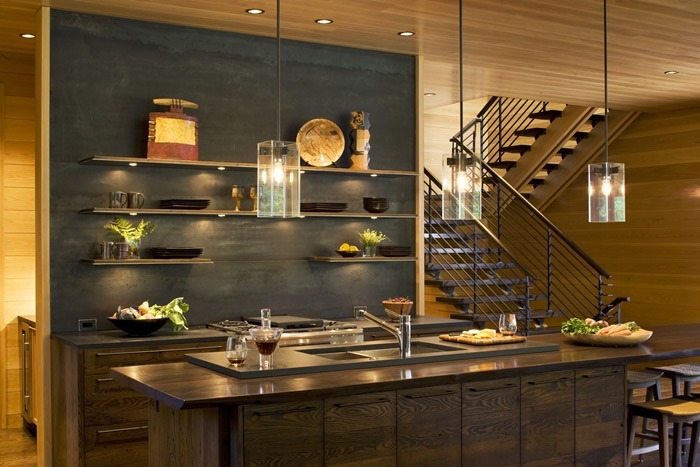Hardwoods in Unlikely Places
Wood-loving Pros No Longer Fear Wet Sites
The no-no’s about using hardwood near a water source are vanishing. And while allowing water to rest on a wooden surface for extended periods will always be a no-no, the American Hardwood Information Center finds that more design professionals are saying yes to client requests for the warmth, charm and richness of natural wood no matter where it’s used, in the bath, the kitchen, and even the basement.
“I recently designed a bathroom that was all hardwood,” reports Douglas Wright, of Miller & Wright Architects in New York City. “The only place we used stone was in the shower. Everything else was maple – floor, walls, ceiling.” What about the inevitable splashing that baths are prone to?
Remember, it’s important to always dry splashes immediately. Wright added that for greater dampness protection, “we applied several coats of matte polyurethane. If water splatters out of the sink or shower, it doesn’t stain anything and with that low-luster finish, the wood looks completely natural.”
For a New Hampshire kitchen, Wright designed a maple backsplash and counter. Wood as a kitchen work surface “seemed kind of crazy at the time,” he says, “but my clients insisted, and it turned out beautifully.” His only caveat, use a cutting board to avoid possible scratches or scars.
To extend the durability of any work surface, a protective sealer is always wise. Wright says, “Applying three coats of polyurethane to wood allows the rich, warm color to come through and you don’t have to worry about the surface. It resists water and cleans easily-just wipe up the splashes and spills.” Other pros agree.
Indianapolis kitchen and interior designer Janice Pattee had no qualms about specifying a walnut countertop for the peninsula in a kitchen makeover. “The cabinets were white-painted maple. For contrast, the client chose grained wood.” She particularly loved the double ogee edge that made the peninsula look like fine furniture. Though it’s mainly a breakfast bar, it often serves as auxiliary work space.
In another kitchen remodel, Mark T. White, of Kitchen Encounters in Annapolis, used another elegant hardwood to create the circular extension to a stone countertop and the top of a rectangular island. “The clients chose cherry because of its color and grain,” he says. “The surfaces were lightly stained for color uniformity, then a top coat and sealer were applied-four coats in all. Of course we urged using cutting boards and trivets, to prevent possible damage from sharp knives or hot pots.”
The flooring, which flows into a formal dining room and a casual family room, is oak with a light- to medium-brown stain. “In an open kitchen like this,” says White, “if we’d switched to tile or some other surface, the floor would’ve become an awkward interruption. And people prefer hardwood to tile or other kitchen flooring materials,” he continues. “It’s generally more comfortable on the legs and feet and more forgiving if you drop something.”

Courtesy of David Dietrich Photography
White remembers a client who wanted wood walls in a bathroom. “We came up with light-toned maple panels trimmed with dark cherry,” he says. “To protect the finish, we used sealer, plus a satin-finish top coat. With normal use and proper cleaning, these surfaces should last indefinitely.”
New York City interior designer, John A. Buscarello, is particularly proud of the wood-enhanced basement he completed in a Long Island home. Dampness was a potential problem because the space was mostly below grade.
According to Buscarello, “The white oak floor is over a plywood subfloor that was built above a liquid vapor barrier applied to the concrete. Several coats of polyurethane were applied to the oak, so the surface is protected and can be cleaned with a damp or dry mop.”
Architect Wright designed a wine cellar entirely of oak for a Southampton homeowner. With a floor of dark-stained oak and the walls and ceiling of limed oak, Wright confesses, “I’d never done a wine cellar where every surface was hardwood. When considering wood in areas like this, it’s important to make sure the homeowners know what to expect in terms of maintenance and durability. There’s always a little humidity in a wine cellar, but once you’ve protected the surfaces with a vapor barrier, they’re fine.”
Designer Pattee agrees and predicts that hardwood will continue to be used in even more unexpected places. “I see a trend evolving where unedited wood will be exposed in all its glory-no stain or varnish, just a natural surface whose beauty and grain can be fully appreciated.”
The consensus among design professionals then, is that you can enjoy the look and durability of natural hardwood no matter where you put it. Be sure to protect the surface against standing water and wear and use it wisely.



